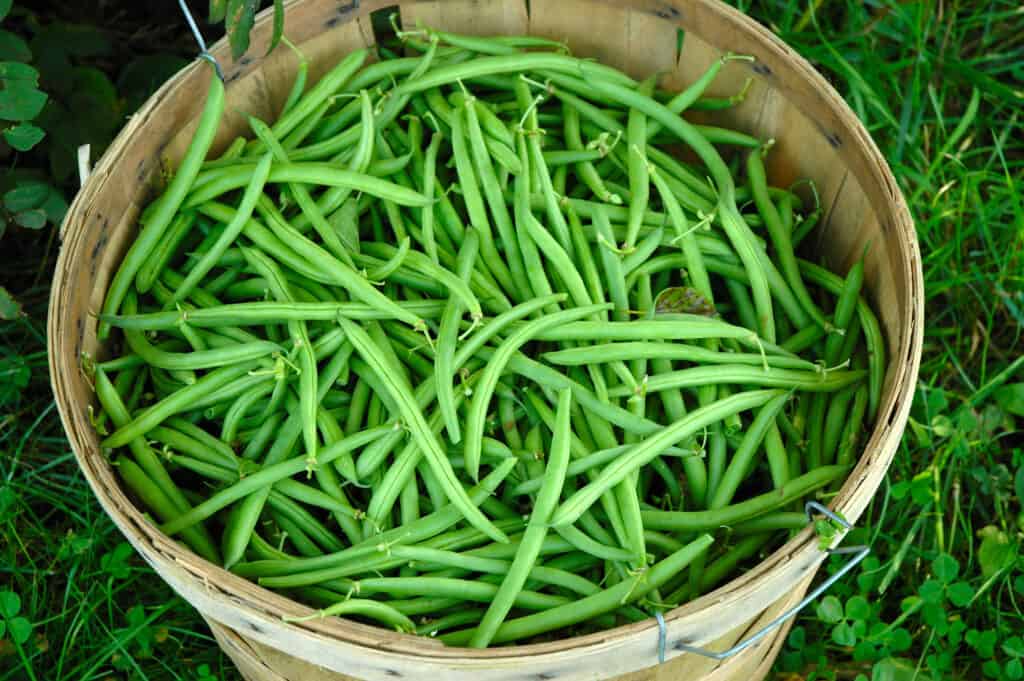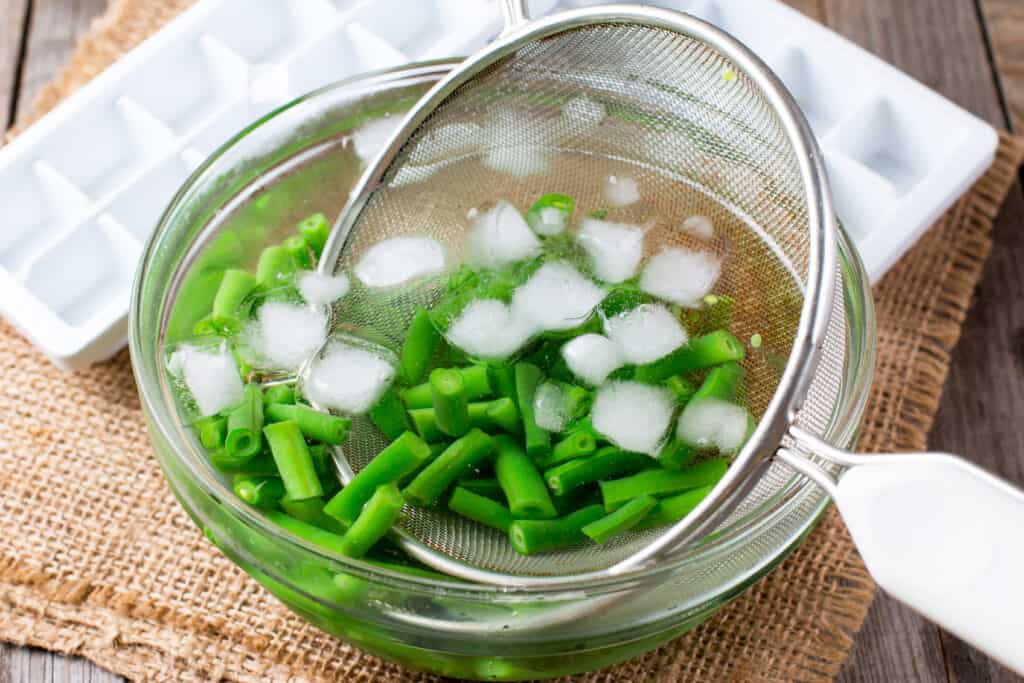Harvest snap beans (also known as green or string beans) before the seeds swell in the pods when they are no more than the diameter of a pencil. Smaller beans can be served as tender, baby snap beans.

When to harvest snap beans
- Start your snap bean harvest about 2 to 3 weeks after the plants begin to bloom and continue to pick almost daily. Snap beans take about 50 to 60 days from sowing to reach harvest.
- At a minimum, harvest pole beans every 2 days and bush beans at least once a week. Pole-type beans generally bear over a longer period than bush types.
- When you quit picking and allow seeds in the pods to develop and mature, the plant will stop blossoming and producing pods; its life cycle will be complete.
- Your bean harvest will end when temperatures drop below 40°F (4°C); then pods will become opaque and develop rust-colored spots.
Related articles:
How to harvest snap beans
- Harvest beans by holding the stem with one hand and pulling pods with the other. Don’t jerk or yank beans from the plant; you will only break vines and branches and injure the plant.
- By picking often, you encourage more blossoms and more beans. Each plant should produce two or three flushes of pods.

How to store snap beans
- Store snap beans in a cool, moist place, 40°-50°F and 95 percent relative humidity. You can keep snap beans in the crisper section of the refrigerator in a perforated plastic bag; this will keep the beans from drying. (You can purchase perforated plastic bags or make your own by punching 20 holes in a medium-size bag; use a hole punch or sharp object.)
- Snap beans will keep for 8 to 12 days in a cool, moist place.
- Do not refrigerate snap beans at less than 40°F; beans are easily injured by cold developing opaque discoloration, rusty spots, and pitting.
- Blanching and freezing is an easy way to preserve a larger snap bean harvest. Blanch whole beans in boiling water for 1 minute and then quickly cool them in ice water and freeze them. This process will brighten and fix the color while preserving the crisp texture of the pods.
Kitchen Helpers from Amazon:
- Oster Vegetable Steamer
- Chef’s Knives Set of 6
- EZ Off Jar Opener for Weak Hands
- Pepper Core Remover Stainless Steel
- Kitchen Utensils – Set of 35
- Rachel Ray Non-Stick Cookware 12pcs
Green beans, shell beans, dry beans — harvest and storage
Your bean harvest time will depend on what you plan to do with the beans after picking.
Snap beans or green beans harvest
Snap green beans are ready for harvest when they are about the size of a pencil. The seeds inside will be just visible–they’ll look like small bumps. Depending on the variety you have planted, snap beans will be ready for picking 50 to 65 days after planting. For a big harvest, pick green beans every day or at least every couple of days. If you allow beans to mature, the plant will stop producing new beans. So pick regularly for an extended harvest. Pinch of cut-off beans; be careful not to pull beans or you may uproot the whole plant. Aging pods will turn yellow and leathery; streaked pods are mealy inside.
Green beans storage
If you can’t keep up with the snap bean harvest at the table, you can freeze or pickle green beans. To freeze green beans, wash the beans and snap off the ends. Cut the beans into 1-inch pieces or slice lengthwise. Blanch the beans for 2 to 3 minutes. Chill. Pack in freezer bags. (To blanch beans, add 1½ to 2 inches of water to the kettle and heat to boiling. Place the colander with beans into the kettle and heat for 2 to 3 minutes.)
Shell beans harvest
Beans for shelling are picked when the seeds reach full size but are still tender. Pick shell beans when the pods are still green and the swollen seeds are visible from the outside. Shell beans are usually ready for harvest 66 to 75 days after planting. Like snap beans, keep picking shell beans and the plant will keep producing; don’t allow the pods to yellow.
Shell beans storage
Shelled beans can be steamed, baked, and boiled for fresh eating. Shell beans also can be frozen: wash the beans and shell them. Blanch shelled beans for 2 to 3 minutes, depending on the size of the bean. Chill. Pack in freezer bags. (To blanch beans, add 1½ to 2 inches of water to the kettle and heat to boiling. Place the colander with beans into the kettle and heat for 2 to 3 minutes.)
Dry beans harvest
Dry beans stay on the plant until the seeds are hard and rattle in the pods. The alternative is to cut the plants when pods turn yellow and hang the plants in a warm dry place until the pods become brittle and the seeds rattle in the pods. It’s best to harvest dry beans before the pods split open and the beans spill out. Dry beans are ready for harvest 90 to 100 days after planting. If the weather forecast calls for rain or frost, pull up the bean plants and dry them indoors. (Pick the pods off of pole beans which are too big to pull up whole. Dry pods on screens or racks indoors.)
Dry bean storage
Store dry beans in airtight jars. Be sure the beans are dry before storing them. To absorb moisture left in beans during storage, place a tablespoon of powdered milk in a folded paper towel inside each jar of dried beans.
Kitchen tips: How to Quick Cook and Serve Snap Beans
Growing tips: How to Grow Green or Snap Beans
Related articles:
How to Plant and Grow Snap Beans
How to Harvest and Store Snap Beans
Bean Growing Problems: Troubleshooting
Five Ways to Quick Cook and Serve Snap Beans
How to Can Green Snap Beans for Beginners
Cooking and Serving Yard-Long Beans
How to Grow Chickpeas and Garbanzo Beans
How to Grow Broad Beans and Lima Beans
Garden Planning Books at Amazon:
- Vegetable Garden Almanac & Planner
- Kitchen Garden Grower’s Guide Vegetable Encyclopedia
- Vegetable Garden Grower’s Guide
- Tomato Grower’s Answer Book
More harvest tips:
Learn when and how to harvest your favorite vegetables for the best flavor and texture. Get storage tips for each crop. Click on the vegetable you are growing below.
- Artichoke
- Arugula
- Asparagus
- Beans
- Beets
- Broccoli
- Brussels Sprouts
- Cabbage
- Cantaloupe — Melons
- Carrots
- Cauliflower
- Celery
- Chard
- Collards
- Corn, Sweet
- Cucumbers
- Eggplant
- Endive and Escarole
- Garlic
- Jerusalem Artichoke
- Kale
- Kohlrabi
- Leeks
- Lettuce
- Melons
- Okra
- Onions
- Parsnips
- Peas
- Peppers
- Potatoes
- Pumpkins
- Radicchio
- Rhubarb
- Rutabaga
- Spinach
- Squash, Summer
- Squash, Winter
- Sunchokes
- Sweet Potato
- Swiss Chard
- Tomatillo
- Tomatoes
- Turnips
- Watermelon















